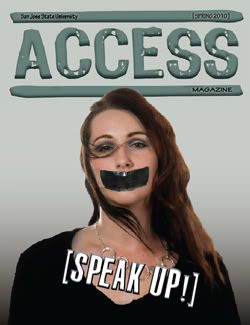Undocumented, Undeterred
Redefining diversity, fairness and social justice through a look at the lives of nonlegal immigrant students at SJSU

Twenty-one percent of SJSU students feel uncomfortable around people of other races, while 41 percent don’t.
Signed in 2001 and effective in 2002, the AB 540 California law has permitted undocumented students to pay resident fees at California public colleges and universities.
“AB 540 became a new term that was safer to use than the term ‘undocumented’ because it states your status. AB 540 is still ambiguous to the broader community, and it’s not so revealing,” said one AB 540 student, who will be referred to as “Maria” for her privacy.
This legislation does not allow for AB 540 students to be eligible for any state financial aid or to participate in most internship programs, due to their legal status. It is the students’ responsibility to pay for their school and living expenses, which can be difficult without a social security number. While SJSU has never been at a loss for students who work hard for an education, there are some students that are truly remarkable.
STUDENT ADVOCATES
Student Advocates for Higher Education, an award-winning SJSU organization geared toward representing AB 540 students and their financial burdens, promotes higher education among immigrant students regardless of their legal status.
“Many students clean houses and do fieldwork. We can’t get work because of citizenship. Many become Spanish tutors [and are paid] under the table,” Maria said.
Last year, SAHE marched against student fee increases on campus. This year, SAHE is working toward making the Associated Students’ “St. S. Saffold Scholarship” inclusive to AB 540 applicants.
In an e-mail, Raymond Sullivan, community liaison for SAHE, said, “The money for the scholarship is provided from student tuition fees, meaning undocumented students are paying for an academic benefit which they are ineligible to receive … There is conflict between [Associated Students’] stated mission to make sure all students are represented fairly and have the right kind of support to pursue their education at SJSU, and the, perhaps, unintended institutionalized discrimination undocumented students now face.”
SIXTH IN THE WEST, FAR FROM THE BEST
According to the U.S. News & World Report’s 2010 edition of “America’s Best Colleges,” SJSU ranked sixth for racial diversity among West Coast universities that offer bachelor’s and master’s degrees.
A news release from the SJSU Office of Public Affairs quoted university President Jon Whitmore, who said that the school’s standing reflects “a model of the global society to come, San José State University is a leader in graduating students of diverse backgrounds.”
“In order for us to be an inclusive campus, [everyone] must recommit to the principles of diversity, fairness and social justice. This is the history of this university and I am asking for recommitment for this coming year,” Whitmore said at the 2009 Fall Welcome Address, where he also introduced the SJSU Inclusive Excellence Diversity Master Plan.
According to the SJSU Web site, the plan is “an institutional strategy … for deeply infusing the university structure and community … with the values and practices of inclusion, belonging, inclusive excellence, intercultural learning and skill sets, and the valuation of multiple perspectives, backgrounds and identities.”
Even if these principles were to apply to SJSU’s AB 540 students, larger conversations about immigration are still rife with animosity, misconceptions and disdain for undocumented people.
“What many people refuse to accept is that [undocumented people] are contributors to state taxes and consumerism,” said Dr. Julia Curry-Rodriguez, faculty advisor to SAHE. “These students are straddling a tight rope. They are facing psychological stigma and economic disparity.”
“We want to contribute to this community,” said Maria. “My experience is worth something. We’re working twice as hard.”
Another AB 540 student, “Grace,” said that “most of the undocumented students I know have been here their whole lives, from at least their early teens.”
THE IMPOSSIBLE DREAM?
An estimated 2.8 million high school graduates will have the option to continue their education and live fulfilled American lives. However, an estimated 65,000 high school graduates will not have this opportunity because they are undocumented.
The Development, Relief and Education for Alien Minors Act would allow undocumented young people to be eligible for a conditional path to citizenship in exchange for a mandatory two years in higher education or military service. In addition to temporary residency, students who meet the act’s qualifications could also apply for student loans and work study. However, students would still not be eligible for Pell educational grants.
“We have a dream, but it is so complicated,” said Maria.
It is complicated. Although the majority of AB 540 students are successfully completing their academic course work and paying their registration dues, their college degree will not guarantee them any greater success in securing a job.
A majority of representatives and senators have co-sponsored the bill, but immigration reform won’t come until next year because the dominant issue is currently health care.
As Aristotle once said, “The roots of education are bitter, but the fruit is sweet.”
The description of education as something bitter resonates strongly with the AB 540 community. The rewards can only be sweet if we subscribe to being that “inclusive campus” President Whitmore spoke of: one that is committed.
Sidebar:
SJSU Racial Diversity Statistics
• A person’s intelligence is not related to his/her race.
Agree: 67%; Disagree: 18%; Neither: 15%
• Racial diversity is one of the main things I like about SJSU.
Agree: 63%; Disagree: 7%; Neither: 30%
• There are racial tensions on campus.
Agree: 15%; Disagree: 54%; Neither: 31%
• Most of my friends don’t associate with people of other races.
Agree: 15%; Disagree: 63%; Neither: 22%
Andrew Martinez
-Research Editor



Latest Comments